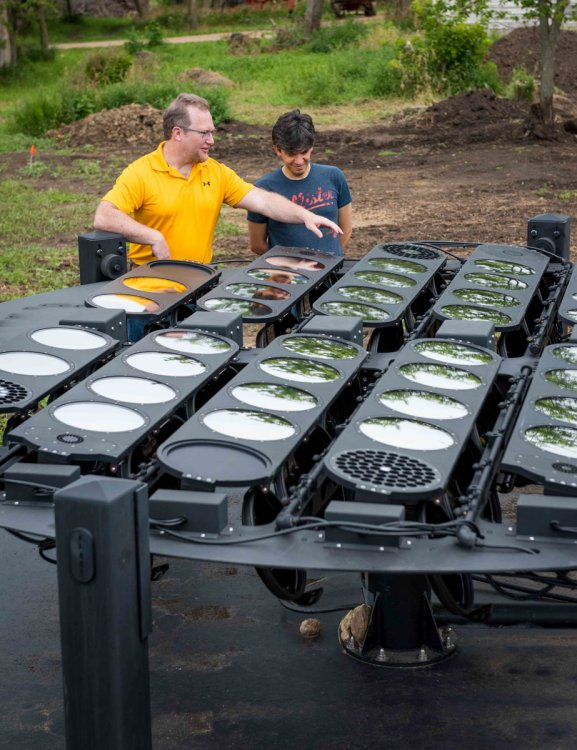Aug 5 2020
A prototype device, which is being tested by imaging engineers from the South Dakota State University, may soon be used for calibrating sensors on satellites used for imaging the Earth, stated Larry Leigh, director of the SDSU Image Processing Laboratory.
 SDSU Image Processing Lab Director Larry Leigh and research associate Pedro Oliveira discuss the functionality of the FLARE system, which uses convex mirrors to redirect the sun’s rays toward satellite sensors. Image Credit: South Dakota State University.
SDSU Image Processing Lab Director Larry Leigh and research associate Pedro Oliveira discuss the functionality of the FLARE system, which uses convex mirrors to redirect the sun’s rays toward satellite sensors. Image Credit: South Dakota State University.
Through a collaboration with a New Hampshire-based electro-optics firm called Labsphere, Leigh and his group will perform studies to validate the latest remote sensing products.
It’s a two-way street. Labsphere wants our opinion about its hardware, which also allows us to pursue some new research areas.
Larry Leigh, Director of Image Processing Laboratory, South Dakota State University
Labsphere is a universal provider of materials, systems, and services for radiometry and photometry applications, such as light metrology, spectroscopy, remote sensing, and image sensor characterization.
The Field Line-of-Sight Automated Radiance Exposure, or FLARE for short, system makes use of convex mirrors to redirect the rays of the Sun toward satellite sensors as well as take radiometric measurements. The aim is to provide customers with a low-cost method to calibrate optical sensors on orbiting satellites, airborne manned aircraft, and unmanned aerial vehicles.
The company has an approach that is unproven. The science says it works; the algorithm says it works, but they have to put an instrument in the field to make sure they can achieve results the industry can get behind.
Larry Leigh, Director of Image Processing Laboratory, South Dakota State University
The Image Processing Laboratory at South Dakota State University is one of the three university labs in the country to perform radiometric satellite calibration.
Satellite sensors emit signals that create digital images made up of pixels. Every pixel quantifies the proportion of energy that is emitted or reflected from the Earth, explained Leigh. Prior to launching a satellite, the sensors are first calibrated, but while these sensors are in orbit, they tend to change or drift.
Measurements are taken by imaging engineers when the satellite travels across a particular site, and those measurements are run via an atmospheric model to estimate the things observed by the satellite sensors. On the basis of those readings, the sensors are calibrated, or tuned, by engineers.
Validating FLARE Calibration
A semitrailer brought the FLARE system in the latter part of June. This system was set up within a matter of days at the location situated 3 miles to the north of Arlington. It measures 16 feet in diameter and sits on a concrete slab measuring 20 feet in diameter. Close to the device is a tower equipped with extra instrumentation stands.
The site of deployment is strategically situated along the route of the Sentinel 2 and Landsat 8 satellites, allowing the team to gather information in all the eight days—provided no clouds cover the Sun.
“This is an alpha product,” added Leigh, observing that the company is striving to decrease the size of the device to boost its mobility. To perform the testing, Leigh has teamed up with Chris Durell, a business development director for remote sensing at Labsphere.
FLARE is a next-generation tool for satellite and airborne imager calibration. It will automate and improve the process of Earth remote sensing and lead to digital imager calibration becoming more accurate, easier and less expensive by several factors.
Chris Durell, Business Development Director for Remote Sensing, Labsphere
Durell further added, “Better calibration means getting more insightful data from every sensor image. Calibrated images means better climate science, weather prediction, agricultural mapping and other vital, beneficial information.”
When a customer tasks a system in the FLARE network via the cloud portal, the rectangular panels flip to show the mirrors, while the platform spins to focus the light of the Sun toward the satellite. This procedure involves just a few mouse clicks and minutes when compared to hours or even days that are currently required through traditional methods, added Durell.
To verify the instrument, Labsphere performs FLARE reflectance measurements “through its algorithm to provide a solid calibration factor,” explained Leigh. In the meantime, the imaging engineers at the South Dakota State University take measurements using “the traditional method we’ve been using for 20 years to see if we come up with the same answer,” added Leigh.
According to him, the testing will take a minimum of 18 months; however, the collaboration may continue much beyond that.
Calibrating New Surface Products
With access to the FLARE hardware, Leigh and his team can find out ways to verify ground-level reflectance data.
Satellite sensors are generally calibrated depending on top-of-the-atmosphere reflectance, but there is a growing demand for products that employ ground-level reflectance. For example, farmers who use these products can assess the health of a corn crop or detect areas that are affected by a disease, explained Leigh.
“It’s a new area when it comes to satellite sensors,” Leigh added.
The Australians and Europeans are attempting to interpret this, while the University of Arizona, the Rochester Institute of Technology, and the calibration team at South Dakota State University are coming up with the American method for ground reflectance validation.
“We want to know how well the sensors and algorithms are doing that,” added Leigh, observing that laboratory clients, like the U.S. Geological Survey, are keen on using this capability.
“That will open new potential avenues for calibration and validation of another level of products that the industry wants,” Leigh concluded.